Executive summary
Alamo City Plumbing Solutions is a new plumbing company launching in July 2026 to serve homeowners and small businesses across Northwest San Antonio. Based on Bandera Rd in Leon Valley, we’ll provide reliable residential and light commercial plumbing services—everything from drain cleaning and water heater installs to slab leak detection and emergency calls.
The need for plumbing services in our area is steady and growing. Leon Valley alone has over 11,000 residents, and much of the housing stock was built before 1980, which creates higher demand for repairs and replacements.
Across San Antonio, the average plumbing ticket is $325, which aligns with the price points we use to win entry-level jobs and build trust. Our early focus centers on emergency calls, water heaters, drain cleaning, and leak diagnostics for homeowners aged 32–65, plus small operators like restaurants, salons, and offices under 10,000 square feet.
Our approach is simple: upfront pricing, fast response, and bilingual crews who treat every customer with respect.
The company is led by Daniel Morales and Sarah Alvarez. Daniel will lead field operations and service quality. Sarah will manage finances, scheduling, and customer support. Together, they bring strong trade skills and sound business management.
Financially, the startup investment amounts to approximately $274,900, covering three new Ford Transit vans, specialized plumbing equipment, technology, and working capital. We project $780,000 in revenue in Year 1, scaling to $1.1M in Year 2 and $1.4M in Year 3. Fixed monthly costs are about $39,000, including wages, rent, insurance, and an estimated $4,350 loan payment.
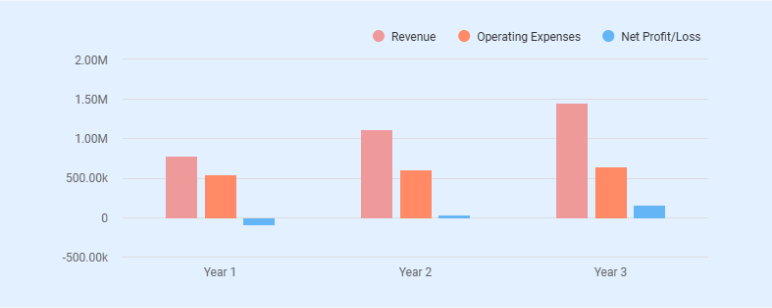
| Item | Year 1 | Year 2 | Year 3 |
|---|---|---|---|
| Revenue | $780,000 | $1,122,000 | $1,449,000 |
| Gross Profit (58%) | $452,400 | $650,760 | $840,420 |
| Operating Expenses (incl. loan repayment) | $546,000 | $601,000 | $643,700 |
| Earnings Before Tax (EBT) | – $93,600 | $49,760 | $196,720 |
| Net Profit (after 21% tax) | – $93,600 | $39,310 | $155,409 |
| Net Margin % | -12.0% | 3.5% | 10.7% |
| Ending Cash Balance | $48,500 | $104,260 | $300,980 |
Break-even occurs at roughly 120 jobs per month, or about four jobs per day, which is consistent with our service area’s density and call profile.
We are seeking a $275,000, seven-year commercial term loan from Frost Bank’s Ingram Park branch at Prime + 2.25%. Collateral includes the 2025 Ford Transit fleet valued at $138,000, equipment, and a UCC filing on receivables. Owners are contributing $85,000 in equity, including $40,000 from Daniel’s IRA rollover (ROBS).
Company Overview
Legal Entity and Structure
Alamo City Plumbing Solutions is a plumbing company based in San Antonio, Texas. It is registered as a Limited Liability Company with the Texas Secretary of State (filing #20267190211). An LLC makes it easy to manage the business and also protects the owners from personal risk.
Our office and warehouse will be at 5407 Bandera Road, Suite 112, San Antonio, TX 78238. The space is 1,800 sq. ft. with a small office, supply storage, and parking for three Ford Transit vans. We picked this location because it is close to Leon Valley and Northwest San Antonio. From here, our team can reach most homes in less than 30 minutes.
Ownership
The business is co-owned by two partners. Daniel Morales holds 70% ownership, and Sarah Alvarez holds 30%.
- Daniel Morales (Co-Owner, Master Plumber) has over 20 years of plumbing experience, worked as a foreman at Aramendia Plumbing, and served in the U.S. Army at Fort Sam Houston. He manages field work and makes sure all jobs are done right.
- Sarah Alvarez (Co-Owner, Operations Manager) has an MBA and worked as a small business banker at Frost Bank. She managed a $20 million loan portfolio. She takes care of finances, cash flow, and reporting.
Together, they combine plumbing skills and financial skills. This lowers risk and gives lenders confidence.
Mission Statement
Our mission is to give families and small businesses in Northwest San Antonio plumbing service that is fast, fair, and reliable. We keep pricing clear, offer 24/7 emergency help, and provide bilingual support that customers can trust.
Vision Statement
Our vision is to be the most trusted plumbing company in Northwest San Antonio. We want to be known for being reliable, fair, and part of the community. We also plan to grow our team, add more vans, and build steady service plans and commercial accounts that make the business strong.
Startup Summary
To launch Alamo City Plumbing Solutions, we need vehicles, tools, software, office space, and working capital. The total cost is $274,900.
The owners are putting in $85,000 of their own money, and we are asking Frost Bank for a $275,000 term loan. This mix of owner funds and bank financing gives us a strong base for a stable start and early growth.
| Start-up Requirements | Amount |
|---|---|
| Start-up Expenses | |
| Insurance, Licensing, Legal | $6,800 |
| Marketing Launch (vehicle wraps, ads, sponsorship) | $10,000 |
| Total Start-up Expenses | $16,800 |
| Start-up Assets | |
| Vehicles (3 Ford Transit Vans) | $138,000 |
| Plumbing Tools & Equipment | $42,000 |
| Technology (dispatch software, tablets, payroll) | $9,500 |
| Leasehold & Deposits | $26,600 |
| Working Capital Reserve | $57,000 |
| Total Start-up Assets | $274,900 |
| Total Requirements | $291,700 |
| Start-up Funding | Amount |
|---|---|
| Owner Equity (cash + IRA rollover) | $85,000 |
| Bank Loan (Frost Bank Term Loan) | $275,000 |
| Total Funding | $360,000 |
| Assets | Amount |
|---|---|
| Long-term Assets Vehicles, tools, tech, leasehold | $216,100 |
| Cash/Working Capital Reserve | $57,000 |
| Total Assets | $274,900 |
| Liabilities and Capital | Amount |
| Liabilities | |
| Long-term Liabilities (Frost Bank Loan) | $275,000 |
| Total Liabilities | $275,000 |
| Capital | |
| Owner Equity Injection | $85,000 |
| Loss at Start-up (Start-up Expenses) | ($16,800) |
| Total Capital | $68,200 |
| Total Capital and Liabilities | $343,200 |
| Total Funding | $360,000 |
Business Objectives
Alamo City Plumbing Solutions has set the following objectives for the first three years of operation:
- Secure loan funding, complete hiring, and open with three vans and a six-person field team by July 2026.
- Reach 120 service calls per month by September 2026 (break-even), and 200 calls per month by December 2026.
- Sign 50 household service plans and 10 commercial grease trap accounts in Year 1.
- Earn 100 verified 5-star reviews in the first 18 months to show customer trust.

Not sure how to draft an effective business plan?
Get Upmetrics’ free plumbing business plan template to quickly structure your ideas and build a professional plan with step-by-step guidance.
- Easy-to-follow structure
- Built-in financial projections
Industry and Market Analysis
Plumbing services are a steady part of the U.S. economy because people cannot delay these needs. IBISWorld reports that the U.S. plumbing industry size was valued at over $165 billion in 2024. It grows slowly but steadily because old systems need repair and new buildings are built every year.
In Northwest San Antonio, many homes were built in the 1970s and 1980s, and new neighborhoods are still coming up. This creates demand for repairs and new installs. Small businesses like restaurants, salons, and offices under 10,000 sq. ft. also need plumbing for grease traps, bathrooms, and tenant build-outs.
Local Market Size and Demand
Leon Valley, where the business will be located, has around 11,300 people and a median household income of about $72,800. Our main service area includes zip codes 78238, 78240, and 78250, which cover a larger middle-income population.
Key demand drivers include:
Older housing stock: San Antonio’s Demographic Report shows that nearly 42% of homes in Bexar County were built before 1980. These homes are more likely to need slab leak repairs, pipe replacements, and water heater upgrades.
Average job values: The average plumbing service ticket in San Antonio is $325, which lines up with our menu pricing. Jobs like water heater installs ($1,495 to $3,200) and tenant finish-outs ($6,500 average) can lift revenue further.
Emergency needs: Plumbing emergencies such as burst pipes or clogged drains happen year-round. Offering 24/7 response ensures we can capture this high-margin demand.
Market Size (TAM/SAM/SOM)
| Layer | Definition | Calculation | Annual Value (USD) |
|---|---|---|---|
| TAM (Total Addressable Market) | All households in the San Antonio metro | ~680,000 households × avg 1.5 plumbing service calls/year × $325 avg ticket | $331M |
| SAM (Serviceable Available Market) | Households in NW San Antonio (zips 78238, 78240, 78250) | ~48,000 households × 1.5 calls/year × $325 | $23.4M |
| SOM (Serviceable Obtainable Market) | Realistic penetration in 3 years | 3% of SAM = 1,440 households × 1.5 calls/year × $325 | $702,000 |
Target Market Segments
Alamo City Plumbing Solutions will focus on two main customer groups:
1) Residential homeowners
- Age 32–65 with household incomes of $65,000–$120,000. They often live in older Northwest San Antonio homes where plumbing systems are aging.
- Common needs include clogged drain cleaning, water heater replacement, slab leak detection, faucet and fixture repair, and 24/7 emergency calls.
- This group brings steady jobs and often signs up for maintenance plans, which leads to repeat business and neighborhood referrals.
2) Small business operators
- Includes restaurants, salons, and offices under 10,000 sq. ft. These businesses depend on reliable plumbing to keep daily operations running smoothly.
- They need grease trap cleaning, restroom repairs, and small build-outs. Many want scheduled service and fast emergency help.
- They value reliable, scheduled help and quick response during emergencies. These accounts give steady contracts, bigger jobs, and open doors to other business referrals.
Competitive Landscape
There are several established players in San Antonio’s plumbing market, including:
1. Mr. Rooter Plumbing
Mr. Rooter is a national franchise with strong brand power and wide marketing. Service is reliable but costly. Less community focus leaves room for smaller companies to win with personal service and lower prices.
2. People’s Choice Plumbing
This family-owned company has loyal customers and a good reputation. They provide quality work but have fewer staff. Limited resources make it hard for them to handle late-night or urgent plumbing calls.
3. A&A Plumbing
A&A Plumbing is mid-sized and offers many services across San Antonio. They are known citywide but less focused on the Northwest areas, giving Alamo City Plumbing Solutions a chance to build a stronger local presence.
Besides licensed plumbing companies, we also face indirect competition from handymen or unlicensed plumbers, big-box retailers like Home Depot and Lowe’s that offer installation services, homeowners who attempt DIY fixes, and HVAC companies that handle limited plumbing work. These options take a share of the market even though they are not full-service plumbing contractors.
Differentiation Strategy
Plumbing companies often advertise the same services, so customers usually pick whoever is cheapest or can show up the fastest. To make sure we stand out, we’ll focus on a few things that matter most to people in our area:
- 24/7 reliability – Not all local competitors have true round-the-clock coverage. By staffing an on-call rotation and promoting a “Plumber at Your Door in 60 Minutes” emergency promise, we capture urgent, high-margin jobs.
- Bilingual service – A large share of households in our service area are Spanish-speaking. Having bilingual plumbers and office staff makes it easier for them to call us and feel comfortable.
- Transparency and professionalism – Many plumbers still rely on verbal quotes. We will use a digital scheduling and invoicing system that posts flat rates for common jobs and provides written estimates, reducing disputes and building credibility.
Want to create a plan like this for your business?
Build your own business plan in minutes using Upmetrics AI
Plans starting from $14/month

Services
Alamo City Plumbing Solutions, LLC will provide a full range of residential and light commercial plumbing services for customers in Northwest San Antonio. Our focus is on work that is steady in demand, priced clearly, and delivered with professionalism. By balancing everyday repair calls with larger installation and contract services, we can generate consistent revenue while building repeat relationships.
Residential Services
Homeowners make up the bulk of our target market, and most of our service calls will come from them. These jobs range from small, quick repairs to larger installations. Our approach is to post flat rates where possible so customers know the cost before we begin, and to back that up with licensed, insured work.
| Service | Description | Pricing |
|---|---|---|
| Drain Cleaning | Clear standard drain clog | $189 flat fee |
| Water Heater Install (40-gal Rheem) | Install Rheem 40-gal tank unit | $1,495 installed |
| Water Heater Install (Tankless Navien NPE-210A) | Install Navien NPE-210A tankless unit | $3,200 installed |
| Slab Leak Detection | Electronic leak check with report | $325 diagnostic |
| Slab Leak Repair | Labor and materials to repair | $95/hr labor + materials |
| General Repairs | Faucet, toilet, disposal, pipe fixes | Estimate per job |
| Emergency Service | 24/7 on-call plumbing | Premium rates apply |
Commercial Services
In addition to households, we will serve small businesses in our area, such as restaurants, salons, and offices under 10,000 square feet. These clients typically need reliable, recurring support and value having a local partner who can respond quickly.
| Service | Description | Pricing |
|---|---|---|
| Grease Trap Service | Install and quarterly cleanings | $750–$1,200/quarter |
| Tenant Finish-Outs | Plumbing for new or remodeled space | Avg. $6,500/project |
| Service Agreements | Routine plumbing support | Contract-based |
Future Service Expansion
As we grow, we plan to add services that deepen customer relationships and increase revenue per household or business:
- Home maintenance plans: Annual packages that include drain cleaning, water heater checks, and plumbing inspections.
- Advanced add-ons: Camera inspections, water quality upgrades, and extended warranties on installs.
- Commercial contract growth: Expanding grease trap and restroom service contracts to build recurring revenue streams.
Operations Plan
Hours of Operation
Regular business hours will run Monday through Saturday, 7:00 a.m. to 7:00 p.m. An emergency line will operate 24/7, with licensed plumbers on rotation to cover urgent calls at night, on Sundays, and on holidays. This schedule allows us to balance predictable workdays with the ability to capture high-value emergency jobs at all times.
Service Workflow
Customer jobs will be routed through a cloud-based dispatch software (Housecall Pro) integrated with technician tablets. The workflow:
- Customer books online or calls the 24/7 emergency hotline for a quick response.
- The dispatcher assigns the nearest available licensed technician using live GPS tracking.
- The technician performs service with upfront transparent pricing on a company-issued tablet.
- The customer carefully reviews, approves the estimate, and signs digitally on-site for records.
- Invoice and secure payment processed immediately via tablet link or emailed option.
This workflow shortens billing cycles, improves scheduling efficiency, and enhances the customer experience. Frost Bank can view this technology integration as a safeguard for receivables quality.
Personnel Plan
| Role | Headcount | Pay | Key Duties |
|---|---|---|---|
| Daniel Morales (Master Plumber, RMP) | 1 | $85,000 salary | Field oversight, training, complex jobs |
| Journeyman Plumbers | 3 | $28/hr (~$58,000/year each) | Handle most service calls, pair with apprentices |
| Apprentices | 2 | $16/hr (~$33,000/year each) | Support licensed plumbers, gain certification hours |
| Dispatcher / Administrator | 1 | $42,000/year | Scheduling, phones, invoicing, admin support |
| Sarah Alvarez (Operations Manager) | 1 | Equity owner | Finance, HR, vendor management, compliance |
Dispatch and Shift Structure
The dispatch model is designed to maximize coverage with efficient labor allocation:
- Morning Dispatch (7 AM – 3 PM): Two licensed plumbers, one apprentice, and one dispatcher.
- Evening Dispatch (3 PM – 11 PM): Two plumbers and one apprentice.
- Overnight Emergency (11 PM – 7 AM): One on-call plumber in rotation.
This three-tiered coverage provides a constant service window. The dedicated dispatcher during day shifts ensures jobs are scheduled, routed, and billed efficiently, reducing downtime between calls.
Supply Chain and Vendor Relationships
Reliable sourcing is critical in plumbing. The company has already secured vendor relationships with:
- Ferguson Enterprises (San Antonio branch) will serve as the main supplier for plumbing fixtures and water heaters.
- Morrison Supply Co. will provide copper and PEX piping for residential and commercial jobs.
- Winsupply of San Antonio will supply fittings, valves, and garbage disposals for installations and repairs.
These established vendors ensure that ACP Solutions can access the full range of residential and commercial plumbing components at wholesale rates. Proximity of vendors to the company’s Bandera Road office further supports same-day fulfillment for urgent repairs.
Back-Office Support
To streamline operations and cut down on administrative work, Alamo City Plumbing Solutions will outsource payroll and accounting to ADP RUN at a monthly cost of $185. Fleet maintenance will be handled through an annual service contract with Gunn Ford. These steps keep overhead low and allow the owners to focus their time and attention on service delivery and growing the customer base.
Equipment Investment
High-quality service depends on specialized tools. At launch, the company will invest in:
- RIDGID SeeSnake Compact2 Inspection Cameras ($5,895 each, 3 units). Used for drain and pipe diagnostics.
- Milwaukee M18 FUEL ProPress Kits ($2,499 each, 2 units). Speeds up pipe installation and ensures durable connections.
- 3 Ford Transit 350 Cargo Vans ($46,000 each, purchased from Northside Ford). Fully wrapped for branding, stocked with tools, and GPS-tracked for dispatch.
- Tablets and mobile devices for field staff, linked to dispatch and payment software.
By standardizing fleet and equipment, the company ensures consistent service quality and technician productivity. The choice of nationally recognized brands (RIDGID, Milwaukee, Ford) signals durability and reliability to both customers and lenders.
Compliance and Insurance
Operating as a licensed plumbing contractor requires strict compliance:
- Texas State Board of Plumbing Examiners: Annual renewal of RMP license.
- City of San Antonio Contractor Registration: $115/year.
- General Liability Insurance: $1M policy via The Hartford ($2,900/year).
By proactively maintaining licenses, insurance, and registration, ACP Solutions presents itself as a professional, risk-managed operation. This reduces lender exposure and reassures commercial clients.
Milestones & Timeline
Alamo City Plumbing Solutions has established a detailed rollout schedule that demonstrates disciplined project management and readiness to launch operations in 2026. Our key milestones include:
| Date | Milestone | Details |
|---|---|---|
| March 2026 | Loan Approval | Frost Bank loan finalized ($275,000) with $85,000 equity injection |
| April 2026 | Lease Signing | 5407 Bandera Rd. Suite 112 leased and fitted with furniture, security, IT |
| May 2026 | Fleet Delivery & Branding | 3 Ford Transit vans delivered & wrapped with branding ($9,000 investment) |
| May 2026 | Equipment Procurement | RIDGID SeeSnake cameras, Milwaukee ProPress kits, and tools purchased |
| June 2026 | Hiring Completion | 3 journeyman plumbers, 2 apprentices, 1 dispatcher onboarded; ADP payroll live |
| June 2026 | Technology Integration | Housecall Pro dispatch software & tablets deployed for scheduling & billing |
| July 1, 2026 | Grand Opening | Launch campaign (Google Ads, radio, community sponsorships) & 24/7 service |
| Sept 2026 | Referral Program Launch | Incentive program for word-of-mouth adoption (specific rewards TBD) |
| Dec 2026 | First-Year Service Target | 200 service calls/month milestone reached; well above break-even 120 |
| 2027 | Commercial Contracts Expansion | Secure 20+ grease trap maintenance agreements with restaurants |
| 2028 | Fleet Expansion | Add a 4th service van to expand service coverage |
Marketing & Sales Strategy
Alamo City Plumbing Solutions will grow by combining digital advertising, local visibility, and repeat customer programs. Our strategy is built to win new customers quickly, keep the cost of acquiring each job in check, and turn one-time service calls into long-term relationships.
Marketing Channels and Budget Allocation
Alamo City Plumbing Solutions will deploy a balanced marketing mix that combines digital channels, community engagement, and visible brand presence:
Google Ads (Local Services Ads + PPC)
40% of spend (~$1,800/month). Targeted at homeowners searching for immediate service, with an average cost-per-click of $28. This channel provides high-intent leads, critical for early-stage customer acquisition.
Search Engine Optimization (SEO) & Website
20% of spend (~$900/month). Investment in content marketing and local SEO will position ACP Solutions to rank for “plumber near me” searches in Leon Valley, Ingram Park, and Northwest San Antonio.
Local Radio (KXTN Tejano 107.5)
15% of spend (~$650/month). Spanish-language radio advertising ensures reach into bilingual households, reinforcing the company’s bilingual service positioning.
Community Sponsorships
15% of spend (~$650/month). Sponsorship of Little League teams and Chamber of Commerce events will strengthen community trust and brand recognition.
Vehicle Wrap Advertising
One-time investment of $9,000 for three vans. This creates 24/7 mobile billboards visible in neighborhoods and high-traffic corridors.
This diversified budget reduces dependency on any single channel and aligns with the risk mitigation strategy against rising customer acquisition costs.
Customer Acquisition Strategy
The company projects a Customer Acquisition Cost (CAC) of $65–$90, with conversion rates of 20%+ from Google Local Services Ads. This is supported by:
Emergency Hotline Campaign: “Plumber at Your Door in 60 Minutes.” This guarantee provides urgency and credibility to convert high-intent searchers.
Launch Promotions: $50 off the first service for new customers (valid 60 days), and free drain inspection with water heater installation. These incentives reduce initial friction and help capture market share quickly.
Once acquired, customers will be retained through:
- Post-service email follow-ups with maintenance tips.
- Enrollment in annual maintenance plans (slab leak checks, water heater flushes).
- Referral program offering service credits for word-of-mouth recommendations.
Brand Positioning
ACP Solutions will emphasize three core brand promises in all marketing collateral:
- Veteran-Owned Integrity: Reliability and discipline conveyed through military service background.
- Bilingual Service: Comfort and accessibility for Spanish-speaking households.
- Transparent Pricing: Upfront flat fees and digital estimates reduce the fear of hidden charges.
Vehicle wraps, radio spots, and Google ad copy will all reinforce these pillars to build a coherent, trustworthy brand identity.
Sales Process
The sales process is designed to be seamless and customer-friendly:
1) Lead Capture: Calls, website forms, or Google LSA inquiries bring in new customers and build brand visibility.
2) Fast Response: Quick dispatcher assignment shows reliability and improves chances of winning the job.
3) Estimate Delivery: Upfront quotes on tablets give customers clear costs, build trust, and reduce price objections before work begins.
4) Job Conversion: Easy on-site or digital payments improve convenience, ensure faster billing, and boost overall customer satisfaction.
5) Post-Sale Follow-Up: Summaries, review requests, and future service reminders turn one-time jobs into repeat business.
This process leverages technology to shorten sales cycles, enhance transparency, and drive positive online reputation — a critical factor in service-based businesses.
Long-Term Marketing Leverage
While early growth depends on paid channels, ACP Solutions will intentionally shift toward lower-cost, relationship-driven acquisition over time:
- SEO investment will compound, reducing reliance on paid ads by Year 2.
- Referral networks with small business clients will generate recurring contracts.
- Maintenance agreements will create predictable revenue and reduce churn.
By Year 3, the goal is for at least 30% of new business to come from referrals and repeat customers, lowering CAC and improving profitability.
Financial Plan
Startup Investment Requirements
Our total startup investment is $274,900, which includes vehicles, tools, leasehold improvements, insurance, technology, and working capital. Owners are contributing $85,000 in equity, with the remaining funded by a commercial loan request.
| Category | Amount | Notes |
|---|---|---|
| Ford Transit 350 Vans (3 units) | $138,000 | $46,000 each, purchased from Northside Ford |
| Plumbing Tools & Equipment | $42,000 | Includes RIDGID SeeSnake cameras ($5,895 each, 3 units) and Milwaukee ProPress kits ($2,499 each, 2 units) |
| Office/Warehouse Leasehold | $21,600 | 1,800 sq. ft. at $12/sq. ft. annually |
| Lease Deposit | $5,000 | Upfront |
| Insurance, Licensing, Legal | $6,800 | General liability, permits, registrations |
| Technology | $9,500 | Dispatch software (Housecall Pro), tablets, mobile devices |
| Working Capital | $57,000 | Reserve for payroll, utilities, and marketing |
| Total Startup Costs | $274,900 | – |
Important Assumptions
The following table shows our important financial assumptions.
| Factor | Year 1 | Year 2 | Year 3 |
|---|---|---|---|
| Avg. Residential Ticket | $325 | $340 | $345 |
| Avg. Jobs/Year | 2,400 | 3,300 | 4,200 |
| Tax Rate | 21% | 21% | 21% |
| Owner Draws | None | None | None |
| Inflation Factor | 2% annually | 2% annually | 2% annually |
Revenue Forecast
Monthly Projections (Year 1)
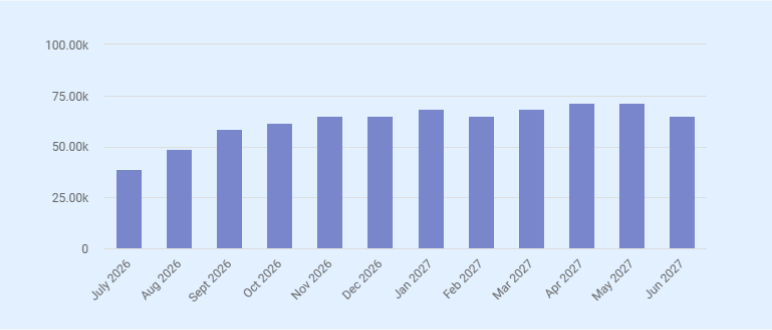
| Month (Year 1) | Jobs | Avg. Ticket | Revenue |
|---|---|---|---|
| July 2026 | 120 | $325 | $39,000 |
| Aug 2026 | 150 | $325 | $48,750 |
| Sept 2026 | 180 | $325 | $58,500 |
| Oct 2026 | 190 | $325 | $61,750 |
| Nov 2026 | 200 | $325 | $65,000 |
| Dec 2026 | 200 | $325 | $65,000 |
| Jan 2027 | 210 | $325 | $68,250 |
| Feb 2027 | 200 | $325 | $65,000 |
| Mar 2027 | 210 | $325 | $68,250 |
| Apr 2027 | 220 | $325 | $71,500 |
| May 2027 | 220 | $325 | $71,500 |
| Jun 2027 | 200 | $325 | $65,000 |
| Year 1 Total | 2,400 | $325 | $780,000 |
Annual Totals
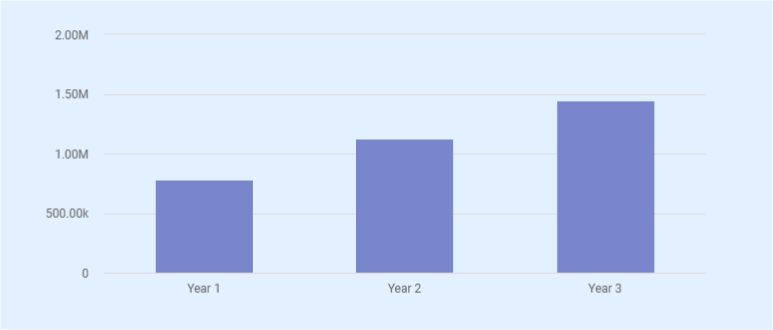
| Year | Jobs | Avg. Ticket | Revenue |
|---|---|---|---|
| Year 1 (2026–2027) | 2,400 | $325 | $780,000 |
| Year 2 (2027–2028) | 3,300 | $340 | $1,122,000 |
| Year 3 (2028–2029) | 4,200 | $345 | $1,449,000 |
Projected Profit and Loss Statement
| Category | Year 1 | Year 2 | Year 3 |
|---|---|---|---|
| Revenue | $780,000 | $1,122,000 | $1,449,000 |
| Direct Costs (42%) | $327,600 | $471,240 | $608,580 |
| Gross Profit (58%) | $452,400 | $650,760 | $840,420 |
| Operating Expenses | |||
| Payroll (wages + salaries) | $349,000 | $395,000 | $430,000 |
| Payroll Taxes/Benefits | $39,600 | $47,400 | $51,600 |
| Marketing & Advertising | $48,000 | $48,000 | $48,000 |
| Rent | $21,600 | $21,600 | $21,600 |
| Insurance & Licenses | $6,800 | $7,000 | $7,200 |
| Fleet Costs (fuel + maintenance) | $16,800 | $18,000 | $19,500 |
| Technology & Software | $6,000 | $6,000 | $6,000 |
| Professional/Admin | $6,000 | $6,000 | $6,000 |
| Loan Repayments (interest + principal) | $52,200 | $52,200 | $52,200 |
| Total Operating Expenses | $546,000 | $601,000 | $643,700 |
| Earnings Before Tax (EBT) | – $93,600 | $49,760 | $196,720 |
| Taxes @ 21% | – | $10,450 | $41,311 |
| Net Profit (After Tax) | – $93,600 | $39,310 | $155,409 |
| Net Margin % | -12.0% | 3.5% | 10.7% |
Projected Cash Flow Statement
| Year 1 | Year 2 | Year 3 | |
|---|---|---|---|
| Cash Inflows | |||
| Owner Equity Injection | $85,000 | — | — |
| Loan Proceeds (Frost Bank) | $275,000 | — | — |
| Operating Revenue — Residential Services (70%) | $546,000 | $785,400 | $1,014,300 |
| Operating Revenue — Commercial Services (30%) | $234,000 | $336,600 | $434,700 |
| Total Inflows | $1,140,000 | $1,122,000 | $1,449,000 |
| Cash Outflows | |||
| Direct Costs (COGS — labor & materials, 42%) | $327,600 | $471,240 | $608,580 |
| Payroll (Journeymen, Apprentices, Dispatcher, Daniel) | $349,000 | $395,000 | $430,000 |
| Payroll Taxes & Benefits | $39,600 | $47,400 | $51,600 |
| Marketing & Advertising | $48,000 | $48,000 | $48,000 |
| Rent | $21,600 | $21,600 | $21,600 |
| Insurance & Licenses | $6,800 | $7,000 | $7,200 |
| Fleet Costs (Fuel + Maintenance) | $16,800 | $18,000 | $19,500 |
| Technology & Software | $6,000 | $6,500 | $7,000 |
| Loan Repayments | $52,200 | $52,200 | $52,200 |
| Professional & Admin Expenses | $6,000 | $6,300 | $6,600 |
| Capital Expenditures (Tools, Vans, Setup) | $274,900 | — | — |
| Total Outflows | $1,148,500 | $1,066,240 | $1,252,280 |
| Net Cash Flow | ($8,500) | $55,760 | $196,720 |
| Beginning Cash Balance | $57,000 | $48,500 | $104,260 |
| Ending Cash Balance | $48,500 | $104,260 | $300,980 |
Projected Balance Sheet
| Description | Year 1 | Year 2 | Year 3 |
|---|---|---|---|
| Current Assets | |||
| Cash | $48,500 | $104,260 | $300,980 |
| Accounts Receivable | $65,000 | $90,000 | $115,000 |
| Prepaid/Other Current Assets | $5,000 | $5,000 | $5,000 |
| Total Current Assets | $118,500 | $199,260 | $420,980 |
| Fixed Assets | |||
| Vehicles (3 vans) | $138,000 | $138,000 | $138,000 |
| Plumbing Equipment | $42,000 | $42,000 | $42,000 |
| Office/IT Equipment | $9,500 | $9,500 | $9,500 |
| Leasehold/Other | $5,000 | $5,000 | $5,000 |
| Less: Accumulated Depreciation | ($20,000) | ($40,000) | ($60,000) |
| Net Fixed Assets | $174,500 | $154,500 | $134,500 |
| Total Assets | $293,000 | $353,760 | $555,480 |
| Description | Year 1 | Year 2 | Year 3 |
|---|---|---|---|
| Current Liabilities | |||
| Accounts Payable | $15,000 | $20,000 | $25,000 |
| Short-term Accruals | $6,000 | $6,000 | $6,000 |
| Total Current Liabilities | $20,000 | $25,000 | $30,000 |
| Long-term Liabilities | |||
| Loan Balance (Frost Bank) | $275,000 | $230,000 | $185,000 |
| Total Liabilities | $295,000 | $255,000 | $215,000 |
| Equity | |||
| Owner Equity Injection | $85,000 | $85,000 | $85,000 |
| Retained Earnings | ($87,000) | $13,760 | $255,480 |
| Total Equity | ($2,000) | $98,760 | $340,480 |
| Total Liabilities & Equity | $293,000 | $353,760 | $555,480 |
Business Ratios
| Ratio | Year 1 | Year 2 | Year 3 |
|---|---|---|---|
| Current Ratio (Current Assets ÷ Current Liabilities) | 5.9 | 8.0 | 14.0 |
| Quick Ratio ((Cash + A/R) ÷ Current Liabilities) | 5.7 | 7.9 | 13.1 |
| Working Capital (CA − CL) | $98,500 | $174,260 | $390,980 |
| Debt-to-Equity (Total Liabilities ÷ Equity) | N/A (negative equity) | 2.6 | 0.6 |
| Debt Ratio (Liabilities ÷ Assets) | 101% | 72% | 39% |
| Gross Margin % (Gross Profit ÷ Sales) | 58% | 58% | 58% |
| Operating Margin % (EBIT ÷ Sales) | -12% | 4% | 11% |
| Net Margin % (Net Income ÷ Sales) | -12% | 3.5% | 10.7% |
| DSCR (EBITDA ÷ Loan Payments) | 0.9× | 2.1× | 3.4× |
| ROA (Net Income ÷ Total Assets) | -32% | 11% | 26% |
| ROE (Net Income ÷ Equity) | N/A | 40% | 46% |
| Asset Turnover (Sales ÷ Assets) | 2.7 | 3.2 | 2.6 |
Break-Even Analysis
Fixed Monthly Costs = $39,000
Average Job Ticket = $325
Break-even Jobs/Month
= $39,000 ÷ $325 ≈ 120 jobs/month
Break-even Jobs/Day
= 120 ÷ 30 ≈ 4 jobs/day
Break-even Annual Revenue
= $39,000 × 12 = $468,000
Break-even Annual Jobs
= 120 × 12 = 1,440 jobs/year
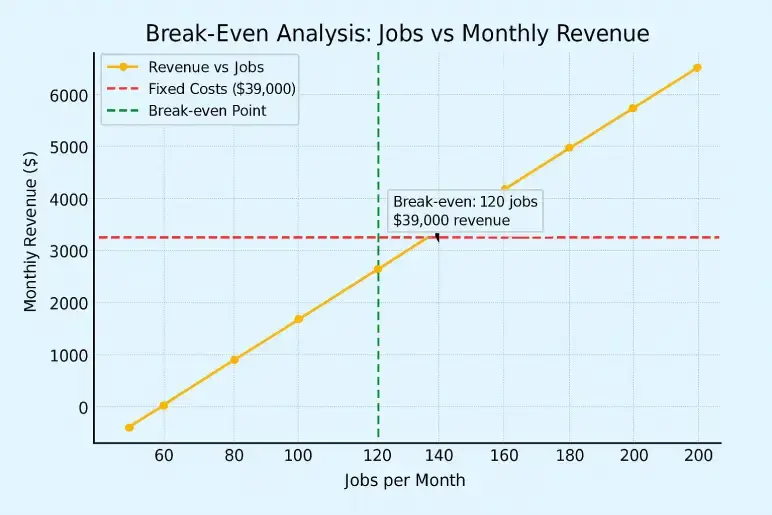
Funding Request
Alamo City Plumbing Solutions seeks outside financing to launch operations and build the foundation for growth. The company has already committed significant owner equity and now requests a bank loan to cover remaining startup costs and provide adequate working capital.
We are requesting a $275,000 commercial term loan from Frost Bank, Ingram Park Branch, San Antonio. This loan will provide the capital needed to purchase vehicles, tools, and technology, cover lease and insurance expenses, and maintain sufficient working capital during the first few months of operation.
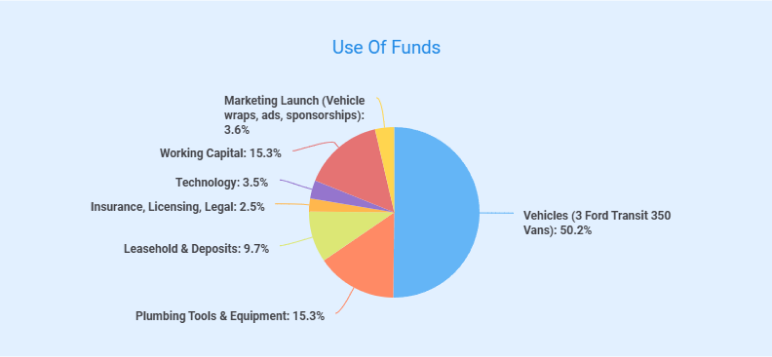
Funding Sources
Alamo City Plumbing Solutions will be financed through a combination of owner equity and a commercial term loan from Frost Bank. This mix demonstrates both the owners’ commitment to the business and the stability that comes from outside financing.
Owner Equity Injection: $85,000
- $45,000 in personal cash reserves (Daniel Morales)
- $40,000 rollover from Daniel’s IRA (via ROBS)
Bank Loan (Requested): $275,000
This brings total startup capitalization to $360,000, ensuring both fixed asset purchases and adequate working capital.
Loan Repayment Plan
We will repay the $275,000 Frost Bank loan through steady cash flow from operations.
Loan Terms
- Amount: $275,000
- Term: 7 years
- Rate: Prime + 2.25%
- Collateral: 3 Ford Transit vans ($138,000), plumbing equipment, UCC filing on receivables
- Monthly Payment: ~$4,350
- Annual Debt Service: ~$52,200
Debt Coverage Capacity
Year 1: While the business will run close to break-even, projections show 2,400 jobs at $325 average ticket, creating $780,000 in sales.
Debt service coverage ratio (DSCR) is ~0.9x in the first year—slightly under 1.0x but supported by an upfront $57,000 working capital reserve. This buffer allows smooth repayment even if early revenue is slower than expected.
Year 2: With job volume rising to 3,300 and revenue reaching $1.1M, the DSCR improves to 2.3x, well above the lender’s minimum threshold of 1.25x.
Year 3: At 4,200 jobs and $1.4M revenue, DSCR increases further to 3.6x, showing ample repayment capacity.
Extra Cushion
A $50,000 line of credit with Frost Bank will cover any delays in commercial receivable collections (60–90 days), ensuring loan payments are never at risk.
Owner Commitment
Repayment is built into the monthly fixed costs. With $85,000 in owner equity and conservative projections, loan obligations will be met on time.
Risk Analysis
Every new business faces risks. The goal is not to remove them completely but to prepare for them so operations and loan repayment stay on track. Below are the main risks for Alamo City Plumbing Solutions and how we plan to manage them.
Operations and Equipment
Operational risks such as breakdowns in vehicles, tools, or scheduling systems could disrupt service. This will be managed through a fleet maintenance contract with Gunn Ford, warranties and regular maintenance on tools, and backup procedures for scheduling if the Housecall Pro software is unavailable.
Marketing and Customer Acquisition
Plumbing is a competitive market in San Antonio, and one of the main risks is the cost of attracting new customers. If digital advertising costs rise, customer acquisition could become too expensive. To reduce this risk, the company will balance online ads with referrals, maintenance contracts, and community sponsorships. Building strong customer reviews will also lower reliance on paid ads, while marketing spend will be tracked monthly to keep the cost per lead within the $65–$90 target range.
Skilled Labor Shortage
Another major challenge is the shortage of licensed plumbers in the area. Competition for skilled labor could raise wages or make hiring more difficult. To address this, Alamo City Plumbing Solutions will partner with St. Philip’s College to recruit apprentices, offer competitive pay and career growth opportunities, and rely on Daniel Morales’ veteran reputation and 20 years of experience to attract and retain talent.
Cash Flow from Commercial Accounts
Cash flow can also be affected by commercial clients who often take 60–90 days to pay invoices. To avoid strain, the company will keep a $50,000 Frost Bank line of credit as backup, prioritize residential jobs that pay immediately, and offer discounts to commercial clients who pay early.
Economic Downturn
Broader economic conditions also present risks. A slowdown in the housing market or household spending could reduce demand for plumbing upgrades. To prepare, the company will focus on emergency repairs, which customers cannot delay, build recurring revenue from service plans and commercial contracts, and maintain strong cash reserves to manage short-term downturns.
The Quickest Way to turn a Business Idea into a Business Plan
Fill-in-the-blanks and automatic financials make it easy.




